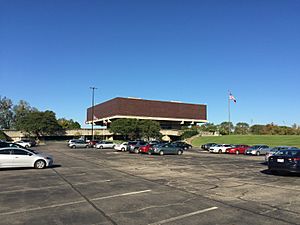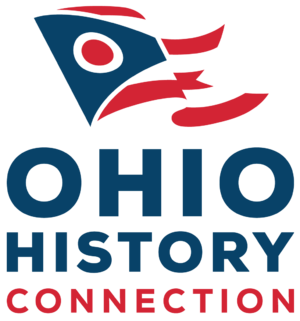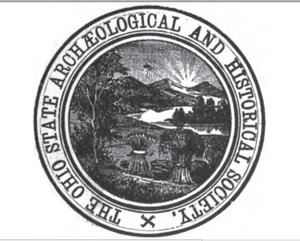Ohio History Connection facts for kids
The Ohio History Connection is a special group that works to save and share Ohio's history. It used to be called The Ohio State Archaeological and Historical Society, and then the Ohio Historical Society. This group started way back in 1885.
Its main office is at the Ohio History Center in Columbus, Ohio. The Ohio History Connection looks after more than 50 museums and historical places all over Ohio. They help people learn about Ohio's past, even its very old history before people wrote things down.
A person named Roeliff Brinkerhoff helped start an early version of this group in 1875. The organization changed its name twice. In 1954, it became the Ohio Historical Society. Then, in 2014, it changed again to Ohio History Connection. Members thought this new name sounded more modern and friendly.
Contents
Discovering Ohio's Past
People in Ohio tried many times to create a history group. In 1822, the state government helped start the Historical Society of Ohio. Important leaders like Jeremiah Morrow were part of it. But this group only met once.
In 1831, another attempt was made. Benjamin Tappan started the Historical and Philosophical Society of Ohio. This group met often in Columbus. However, after a money problem in 1837, fewer people joined. The group moved to Cincinnati in 1848, hoping more people there would be interested. This move helped the group grow and work with the Cincinnati Historical Society.
In 1875, a new group called the Archaeological Society began at the home of Roeliff Brinkerhoff in Mansfield, Ohio. The state government gave $2,500 to help create an exhibit for a big show in Philadelphia in 1876. This society was active until 1883. It started up again two years later in 1885. Governor George Hoadly asked scholars to meet in Columbus. Sixty men attended a two-day meeting. On March 13, 1885, the Ohio State Archaeological and Historical Society officially began. Allen G. Thurman was its first president.
The state government started giving money to the group in 1888. This made the partnership stronger. The state could then choose six of the fifteen people on the group's board. The organization also began looking after historical sites in Ohio. The first site was Fort Ancient State Memorial in 1891.
The Ohio State Archaeological and Historical Society first had its office at the Ohio Statehouse. Later, in 1894, it moved to Ohio State University's Orton Hall. On May 30, 1914, the group opened a large museum building near Orton Hall. They stayed there until 1970. That building is now part of Ohio State University and is called Sullivant Hall.
In 1954, the group's name became shorter: Ohio Historical Society. It changed again in 2014 to Ohio History Connection. Research showed that the word "society" made the group seem "exclusive" or old-fashioned. The new name was chosen to make the organization seem more welcoming and modern. Many other historical groups across the United States also dropped "society" from their names around this time.
Since 2009, the organization has been working with Native American tribes. They want to include Native American ideas and history. The Ohio History Connection has more than 7,100 Native American remains. These are covered by the Native American Graves Protection and Repatriation Act from 1990. The group talks with 45 federally recognized American Indian Tribes. These tribes are descendants of those who signed the Treaty of Greenville in 1795. The Ohio History Connection has been actively working since 2016 to help connect these Ancestors with their tribes.
As of 2014, the Ohio History Connection manages 58 museums and historical sites. These are spread across 40 of Ohio's 88 counties. They have about 1.6 million historical items. They also store 70,000 cubic feet of records and 250,000 images. From 2010 to 2014, the number of members in the group grew by more than 20 percent, reaching 7,563 members.
Ohio History Center: The Main Hub

The Ohio History Connection runs many historical sites in Ohio. Its main building is the Ohio History Center in Columbus. This large building is 250,000 square feet. It has a unique, strong concrete design. Inside, you can find many exhibits about Ohio's history. These exhibits cover everything from the Ice Age to today.
The Center also has state archives, a library, a gift shop, and places for offices and learning. In 1989, a guide called Smithsonian Guide to Historic America said the center was "probably the finest museum in America devoted to pre-European history."
The group's first permanent home was in Sullivant Hall at Ohio State University. They had a museum and library there. Later, the archives moved to the Old Governor's Mansion. In 1965, people voted to approve money for a new building. W. Byron Ireland designed the current building. It uses concrete in a special way, making parts of it seem to hang in the air. The building looks much the same today, even its outside walls made of Ohio silo tiles.
Ohio Village: A Step Back in Time
Ohio Village is a special area at the Ohio History Center. It's like a town from the 1890s that has been rebuilt. It is a "living museum." This means volunteers dress up and act like people from that time.
In 2002, the Ohio Village had to close for a while due to money cuts. It only opened for special events or school groups. But in the summer of 2012, it reopened to the public. Now, volunteers help run it. They even buy their own costumes and work at least 16 hours each season. The Ohio Village tries to make history come alive. Volunteers play characters who really lived in the mid-to-late 1800s. You can visit the village from Memorial Day weekend through Labor Day weekend. It also opens for special events like All Hallows Eve and Dickens of a Christmas.
The village is home to the Ohio Village Muffins. This is a vintage base ball team that started in 1981. They play against other old-style teams from Ohio and other states. The team's name, "Muffins," comes from an old baseball term for a mistake or "error." A team's third-string players were sometimes called the "muffin nine." The Ohio Village Muffins help keep the old rules of baseball alive. They pitch underhand, do not use gloves, and wear uniforms from the 1860s. Ohio Village also has a women's team called The Diamonds. Women's baseball leagues began in 1866, with teams forming at colleges.
Learning with Ohio History Connection
The Ohio History Connection also helps teachers and schools. They offer field trips, outreach programs, and special learning kits. These kits help teachers add more to their lessons. They also have online learning courses. The Ohio Educational Resources Center is connected to the Ohio History Connection. It lends materials to teachers.
The group also hosts public events. These include speakers, plays, workshops, holiday gatherings, and presentations. The topics can be about anything from the Underground Railroad to Ohio's role in other big historical events.
The Ohio History Connection publishes Ohio History Central. This is a huge online encyclopedia about Ohio's history. Ohio History Central has over 3,000 articles about Ohio's nature, early history, and more recent past. It also has nearly 2,000 images. You can search the site or look for articles by topic, time period, or region. It also has image galleries, quick facts about Ohio, and a timeline of Ohio events. Users can even create their own collections of articles and images.
The Ohio History Connection also keeps an online collection of Ohio History. This is a scholarly journal that first came out in 1887. Since 2007, Kent State University Press has published it.
Historical Sites by Region
The Ohio History Connection manages many historical, archaeological, and natural history sites across Ohio. Members can visit these sites for free. Sometimes, the Ohio History Connection works with other groups to manage a site, like Serpent Mound.
Northeast Ohio Sites
- Custer Memorial, New Rumley
- Fort Laurens, Bolivar
- McCook House, Carrollton
- Museum of Ceramics, East Liverpool
- Quaker Meeting House, Mount Pleasant
- Schoenbrunn Village, New Philadelphia
- Shaker Historical Museum, Shaker Heights
- Tallmadge Church, Tallmadge
- Youngstown Historical Center, Youngstown
- Zoar Village, Zoar
Northwest Ohio Sites
- Neil Armstrong Air and Space Museum, Wapakoneta
- Cedar Bog, Urbana
- Cooke House, Sandusky
- Fallen Timbers, Toledo
- Fort Amanda, Lima
- Fort Meigs, Perrysburg
- Fort Recovery
- Glacial Grooves State Memorial, Kelleys Island
- Hayes Presidential Center, Fremont
- Indian Mill Museum, Upper Sandusky
- Inscription Rock, Kelleys Island
- Lockington Locks
- Piqua Historical Area
Central Ohio Sites
- Flint Ridge State Memorial
- Hanby House
- Harding Home
- Harding Tomb
- Logan Elm
- Newark Earthworks: Great Circle Earthworks
- Newark Earthworks: Octagon Earthworks
- Newark Earthworks: Wright Earthworks
- Ohio History Center
- Ohio Village
- Shrum Mound
- Wahkeena Preserve
Southwest Ohio Sites
- Adena Mansion
- Davis Memorial
- Dunbar House
- Fort Ancient
- Fort Jefferson
- Fort Hill State Memorial
- Grant Birthplace
- Grant Boyhood Home
- Grant Schoolhouse
- Harrison Tomb
- Miamisburg Mound
- National Afro-American Museum & Cultural Center
- Rankin House
- Serpent Mound
- Story Mound
- Stowe House
Southeast Ohio Sites
- Big Bottom, Stockport
- Buckeye Furnace, Wellston
- Buffington Island
- Campus Martius, Marietta
- Leo Petroglyph
- McCook Monument
- National Road/Zane Grey Museum, New Concord
- Ohio River Museum, Marietta
- Our House
See also
- History of Ohio
- Columbus Historical Society
- List of historical societies in Ohio



